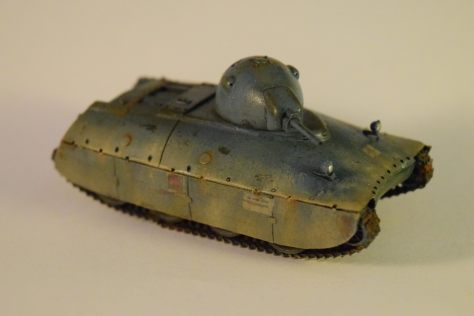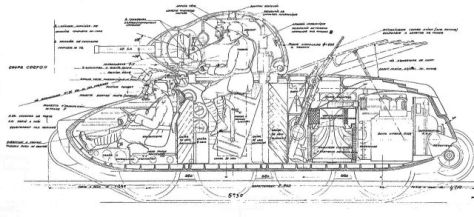
This is one of those tanks that definitely has a lot of personality. From absolute obscurity it was launched into the general consciousness* by the online game World of Tanks, which features it as a tier IV light tank. It has a certain notoriety as it is certainly one of the worst tanks in the game, but despite of this it became somewhat of a legend (or a cult, rather) simply due to its quite unique looks. It’s a sort of hipster tank, just like the Churchill Gun Carrier. The WoT community has created several amusing memes around it, and it has its own nickname: “The Duck”. Right now the only mod I run with the game is the “rubber duck” custom paintjob. (See below)
*Well, more accurately, into the general consciousness of a certain gaming community…
The unique look of the tank is the result of its designers taking the idea of sloped armour to its limits. The plans were drawn up in 1940 as a replacement option for the S35 and S40 cavalry tanks, but due to the German invasion these plans did not materialise; no prototypes were ever built. (To be fair it would have probably performed just as bad in real life against panzer IIIs and IVs as it does in-game.) The only contemporary image of this strange-looking tank available online is a drawing. The tank did inspire a lot of online creativity, thought…


I have been toying around with Blender trying to make a printable model of this tank, but so far my efforts are less than satisfactory. (I’m not giving up, though; if I succeed I will paint it in the Rubber Duck scheme.) Needless to say when I saw that OKB is producing a version of this vehicle I ordered one at once. I quite like this feedback of computer games into the scale model industry; a lot of newer releases (KV-4, AT2, etc.) were clearly inspired by the weirder prototypes, paper panzers popularized by WoT.
The kit comes in a typical OKB box, the parts placed into ziplock bags. The instructions are computer generated and quite simple, but this is a simple model after all. Once you finish the suspension/running gear (I have no idea if they are accurate), you’re essentially finished. It comes with two PE parts, and two transparent resin pieces for the headlights. It lacks the back-mounted machine gun that was planned (that up-pointing gun mounted behind the turret). Other than that it looks very similar to the blueprint, but distinctly different from its in-game representation. (Which is a shame, because the WoT turret with its secondary machine gun turret looks much better in my opinion. It’s absolutely fictional, but looks trump historical accuracy. Well, this is what Blender is for, I guess.)
The model went together without a hitch. The suspension arms fit well, the wheels went on nicely, and the tracks were a breeze to install; that was pretty much the extent of the build, really. Apart from this I had to glue the turret and the gun in place, install the headlights, and add the side-skirts. The building process took about an hour. The only tricky part was to fix the side-skirts onto the curved profile of the tank.
The painting was also pretty easy: I primed the model with the side-skirts off with Vallejo’s German Grey primer, and applied AK’s Chipping Fluid. Once dry, I mixed up the (fictional) blue-gray color from WoT using Tamiya paints, and misted it over the model in several layers. This was followed by some moderate chipping using a wet, stiff brush.
When the model was dry, I used some oil-paint based filters (light brown, blue) to modulate the base color somewhat, and sealed everything with gloss varnish.
Unfortunately there are no decals provided with the model.
After weeks of consideration I decided to test out printing waterslide decals using an inkjet printer. The results were not satisfactory (I used transparent decal paper instead of white, and the colors are very faint), but life is about learning, right? If you want to have faded markings, print decals -that’s my conclusion. The other -bigger problem- is the thickness of the decals; they are just not going onto the surface very well, you can see silvering despite of soaking the whole model in decal softeners, and in general, just being crappy decals. Conclusion? Buy an aftermarket set next time…
The headlights were painted using a chrome pen.
I added the decals, sealed them, and painted on some more scratches and chips. Using Tamiya’s makeup set I added some dust on the lower part of the chassis; and this concludes the painting and weathering phase; the Duck is ready.
Overall the model is nice: well designed, easy to assemble, and unique-looking. The price is moderately high, but affordable; it’s great as a weekend project (or for the true fans of Le’Duck).





























































































































